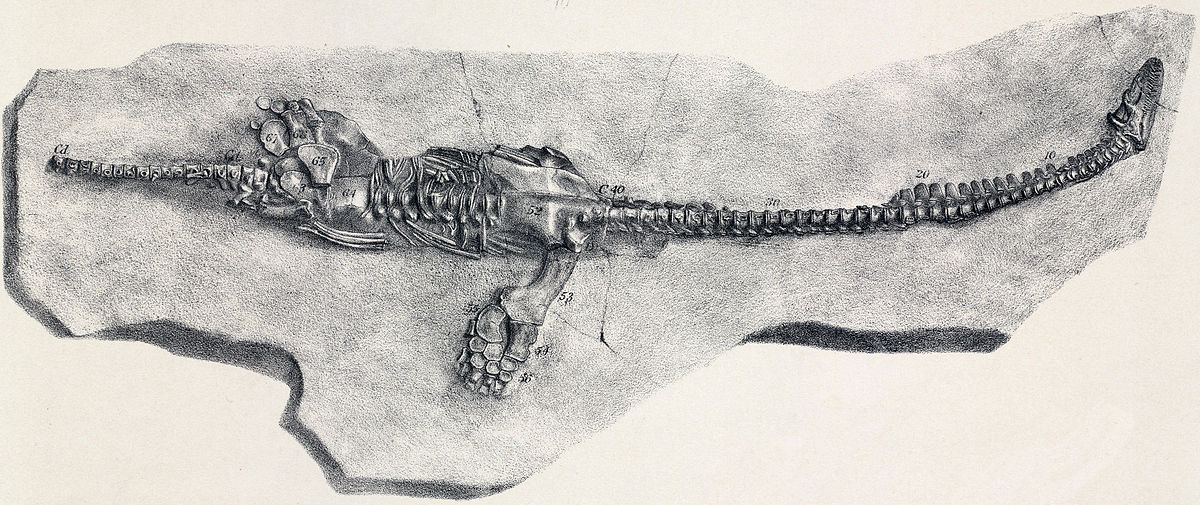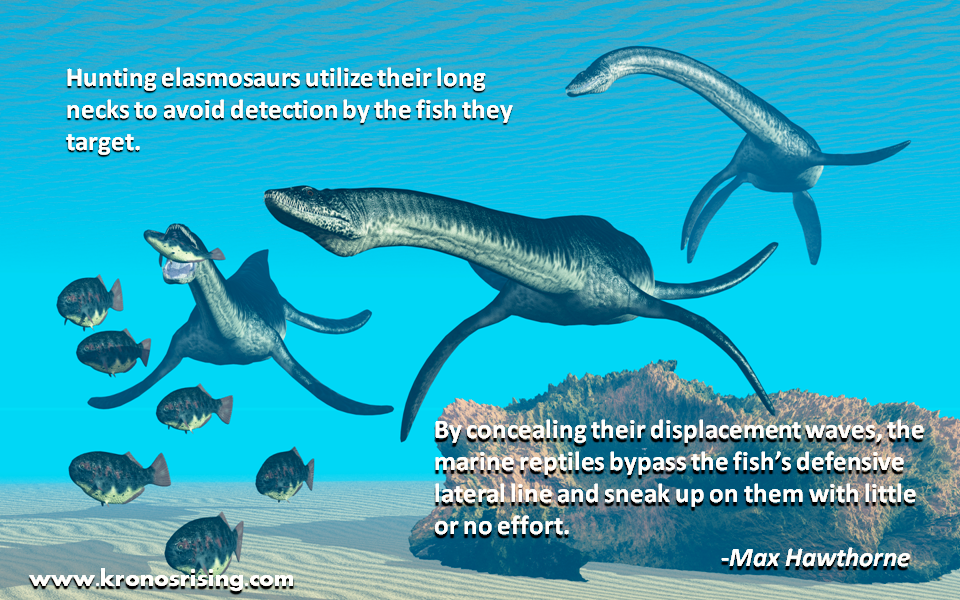Both paleontologists and the public have wondered since their initial discovery why the different plesiosaur species, and elasmosaurs in particular, had such long necks. To this day, questions abound about the snake-like appearance of their foreparts. Why did evolution give these animals cervical vertebrae in such numbers? Was there any advantage to it? Weren’t they vulnerable to predators? And wouldn’t that make them clumsy and slow swimmers that had a hard time changing direction?

The first thing we have to appreciate is that the fossil record shows that these animals first appeared in the late Triassic, approximately 205 million years ago, and survived until the end of the Cretaceous. Nature doesn’t give a faulty or flawed design the ability to survive for 140 million years, so there was obviously some sort of evolutionary advantage to having a neck that would make an ostrich hang its head in envy.
Many theories have abounded about plesiosaur necks. In the beginning, when it was thought they hunted for fish from the shore or via exposed reefs, the belief was that they used their heads and necks like giant fishing rods, dipping in the water and snatching up passing fish like hors d’oeuvres off a tray. Obviously, we now know shore-hunting was not a likely option. More recently, some researchers have offered the opinion that the animals used their necks to root around for food on the sandy bottom or to find suitable-sized gastroliths (stomach stones). Others believe that they used their necks to battle one another for dominance, like aquatic giraffes. Still others theorized they stored food in their necks, and there have even been some that offered up the notion that plesiosaurs had electrical currents inside their necks like electric eels, which they used to shock their prey. I’m waiting for someone to come up with a theory that the vertebrae had specialized bones that skinned, filleted, de-boned, and even microwaved the fish as they traveled from the predator’s head to its stomach!

All jokes aside, of all the proffered theories, the only one that’s been close to the mark is the notion that the long neck allowed the plesiosaur to sneak up on its prey by concealing its huge body from far off. This theory is actually accurate (Occam’s razor, anyone?), although no one has ever explained the mechanics of it, nor explored how it would benefit the animal. I’m going to do so now, and in detail.
Plesiosaurs were fast swimmers and highly maneuverable. But so were the fish they hunted. Fish have a variety of senses to allow them to detect predators, and they also tend to travel in schools, which increases their awareness. Schools can scatter when frightened or attacked and they also incorporate a technique called murmuration, wherein they unexpectedly change direction en masse. This makes it hard to pick off an individual victim, affording more protection to the school as a whole. In addition to their usually keen eyesight, fish have a lateral line – a series of sense organs running along their bodies – that allows them to sense movement and vibrations in the surrounding water. This keeps fish from bumping hard into one another and helps them find prey and avoid predators, even in complete darkness. As a result, fish are sensitive to the displacement wave caused by approaching objects, including floating debris, boats, and predators. This would have included plesiosaurs, whose huge bodies, not to mention the added turbulence cause by their pectoral flippers, would have set off all manner of lateral line alarms.
The elongated neck of Plesiosauromorphs evolved to allow them to overcome these biological defenses. When approaching fish from below or the back (the best way, as the prey’s eyes were then useless), an animal like a shark or crocodile would be quickly discerned by the water it pushes ahead of its body, i.e. its displacement wave. The size of this wave would tell the fish that there was something large and dangerous coming up behind them at high speed. They would then take evasive action or possibly scatter.
By putting a snake-like head at the end of a long neck, the plesiosaurs bypassed the fish’s lateral line defensive strategy. With the marine reptile’s head being about the same size as the fish it hunted (and given their jaws’ ability to stretch to accommodate prey the size of their head, we can safely assume that this was usually the case) the displacement wave produced by the head would not be detected as a threat by the schooling fish. It would come up on their “scope” as just another member of the school and would be automatically dismissed as a non-threat. This would effectively allow the plesiosaur to follow the school along and basically graze like a cow, swimming with the fish, clamping down on a victim at the rear of the school, and then dropping back a few feet to gulp it down before repeating the scenario over and over.
This technique was highly advantageous as it would not have alarmed the school, which would have promptly dispersed. A single fish the size of its small head would not have provided sufficient protein for a multi-ton elasmosaur. So you can bet it was following the school along like a hungry diner at a buffet line, methodically gulping down fish after fish until it was satiated.

The evolutionary benefits of this went both ways. It gave the plesiosaurs a virtually unlimited food supply and also killed off the slowest and weakest members of any given school of fish, thus ensuring the passing on of the healthiest genetics. The result was a self-sustaining ecosystem, geared toward genetic perfection.
You can also bet that the assorted plesiosaur species gravitated toward certain (and most likely readily available) species of fish, and that these fish varied in speed, maneuverability, and the sensitivity of their lateral line. This sensitivity would determine the distance at which they could detect approaching displacement waves and would, hence, account for the super-long neck of elasmosaurs like Thalassomedon and Elasmosaurus. You can bet that the fish these giants were hunting had the strongest sensory organs of all, with the result that the marine reptiles necks grew longer and longer to overcome this sensitivity. It was an evolutionary arms – or rather, neck – race that “stretched” over the eons (pun intended).
So there you have it folks. My personal theory/explanation as to why plesiosaurs evolved the long necks they had (or is it have?). One great thing about being a novelist instead of a paleontologist is that I’m not subject so much to the pressure of peer reviews. I have no problem sticking my neck out when it comes to expressing my ideas.
I hope you enjoyed this one, and feel free to comment.
Best,
Max Hawthorne
UPDATE: A press release for this article was published on 2/8/2019: https://www.einnews.com/pr_news/475941432/author-max-hawthorne-solves-a-65-million-year-old-sea-monster-mystery?fbclid=IwAR2vYrpjnLA-lsMc_KCw2Of9dJc3KAdmHAOqncVP5QzV9qHIXJAq9q9Vm7Q


